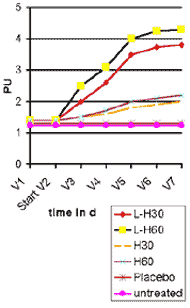HEPARIN
modifies the physiological processes of blood clotting by influencing various aspects of enzymatically catalysed reactions involved in the coagulation cascade.
Results obtained with topically administered heparin demonstrated markedly increased thrombolysis (Tauschel et al, 1984). Kuglmeier (1990) concluded from his experiments with topically applied heparin a significantly increased reabsorption of induced haematomas and thus healing of subcutaneous wounds accompanied by haematomas may be greatly accelerated by intensive topical application of heparin ointments.
In summary the therapeutic efficacy of many heparin preparations following topical application has been investigated in numerous valid clinical trials; the results demonstrate that the tested preparations are effective in the adjuvent therapy of:
MIKA-heparin-spray has been developed by MIKA Pharma GmbH and is used in acute swellings after obtuse injuries and superficial thrombophlebitis. The administered heparin (pig mucosa) is effective in deeper skin areas where injured tissue is regenerated. Improved microcirculation within the treated area is indication of bioavailability and efficacy as well as the increased rate of regeneration (see following figure). Within this 5-day treatment Artmann et al. (1995) demonstrated an improvement in microcirculation of 220% as compared to placebo and untreated cases. In comparison to conventional gels the microcirculation was improved by a factor of 4!
